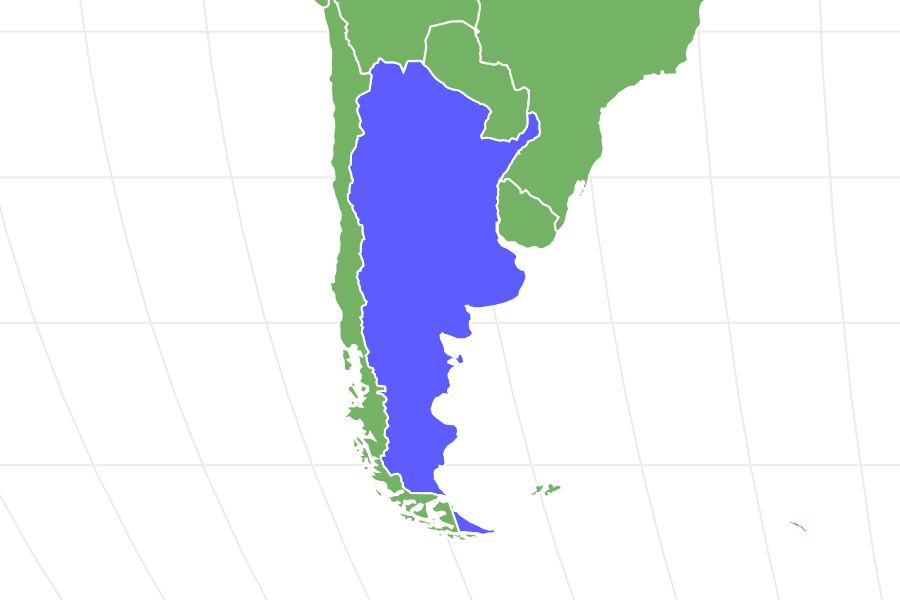The smallest known species of Armadillo
Advertisement
Pink Fairy Armadillo Scientific Classification
- Kingdom
- Animalia
- Phylum
- Chordata
- Class
- Mammalia
- Order
- Cingulata
- Family
- Dasypodidae
- Genus
- Chlamyphorus
- Scientific Name
- Chlamyphorus truncatus
Read our Complete Guide to Classification of Animals.
Pink Fairy Armadillo Conservation Status
Pink Fairy Armadillo Facts
- Main Prey
- Ants, worms, plant material
- Habitat
- Dry Grasslands and Sandy Plains
- Predators
- Domestic Dogs
- Diet
- Omnivore
- Average Litter Size
- 1
View all of the Pink Fairy Armadillo images!
“The smallest known species of armadillo”
Also known as the Pichiciego, the pink fairy armadillo is the smallest known species of armadillo. It lives in the sandy plains and dry grasslands of central Argentina and other parts of South America. Unique adaptations like an aerodynamic body shape, smooth dorsal shell, and sharp claws mean this creature is able to completely bury itself in the sand in a matter of seconds and then navigate underground with ease. Similar to a mole, the pink fairy armadillo will spend the vast majority of its life underground. It is also nocturnal, only emerging ocassionally at night to find food.
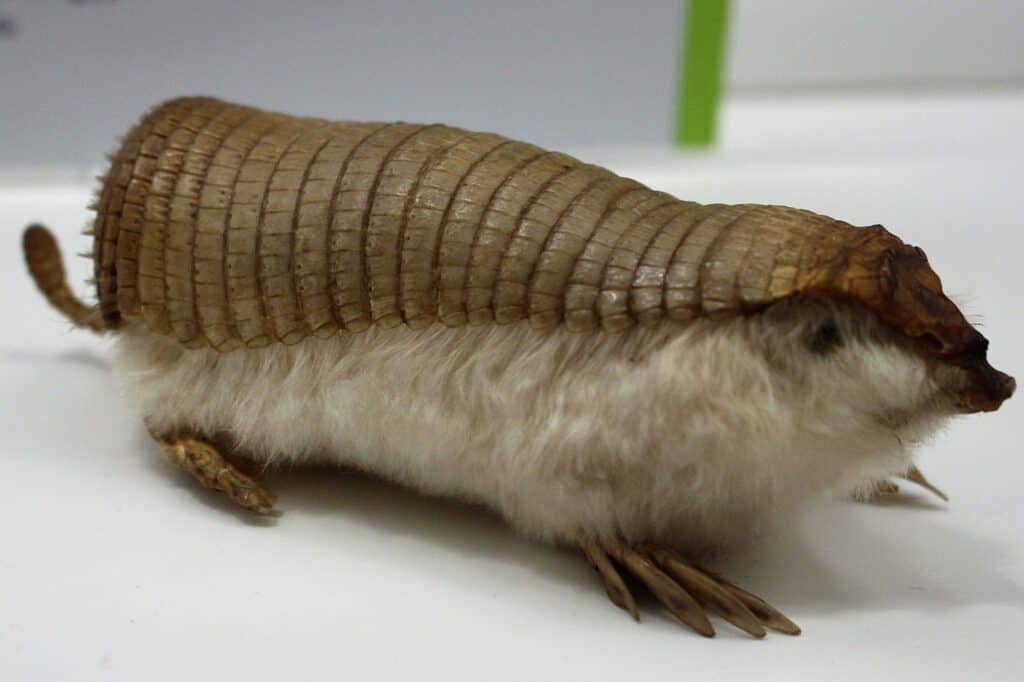
The amazing pink fairy armadillo looks like a blend of different animals.
4 Amazing Pink Fairy Armadillo Facts
- Pumps blood through its shell to regulate body temperature!
- At approximately 13cm in length, it is so small it can fit in your hand!
- Also known as ‘the sand swimmer’ because of how quickly and easily they can navigate underground!
- The only armadillo species whose dorsal shell is not completely attached to its body!
Scientific Name
The Pink Fairy Armadillo’s scientific name is Chlamyphorus truncatus. The animal is also known as ‘the sand swimmer’ because of their uncanny ability to burrow and navigate underground. The animal is named for the uniquely pink color of its protective armor. The first known published description of the pink fairy armadillo was by Richard Harlan in 1825.
Evolution
While not much is familiar in the history of the pink fairy armadillo because of their rare and elusive nature, it is known that the armadillo species originates from South America where it is thought to have an ancient relative dating back more than 60 million years, although the first actual armadillo-type animal is believed to have evolved around 32 million years ago. This mammal was able to make its way to Central and North America when the continents combined. It is believed that this smallest mammal was a result of an adaptation to their environmental changes paired with their subterranean lifestyle.
Types Of
There are only two known living species of the fairy armadillo. The pink fairy armadillo (Chlamyphorus truncatus) and the greater fairy armadillo (Chlamyphorus retusus). Because they have a shared common ancestry, the greater fairy armadillo, also known as the chacoan armadillo, has similar traits, characteristics, and personalities. They are both thought to be extremely elusive, rare and sightings are few and far between.
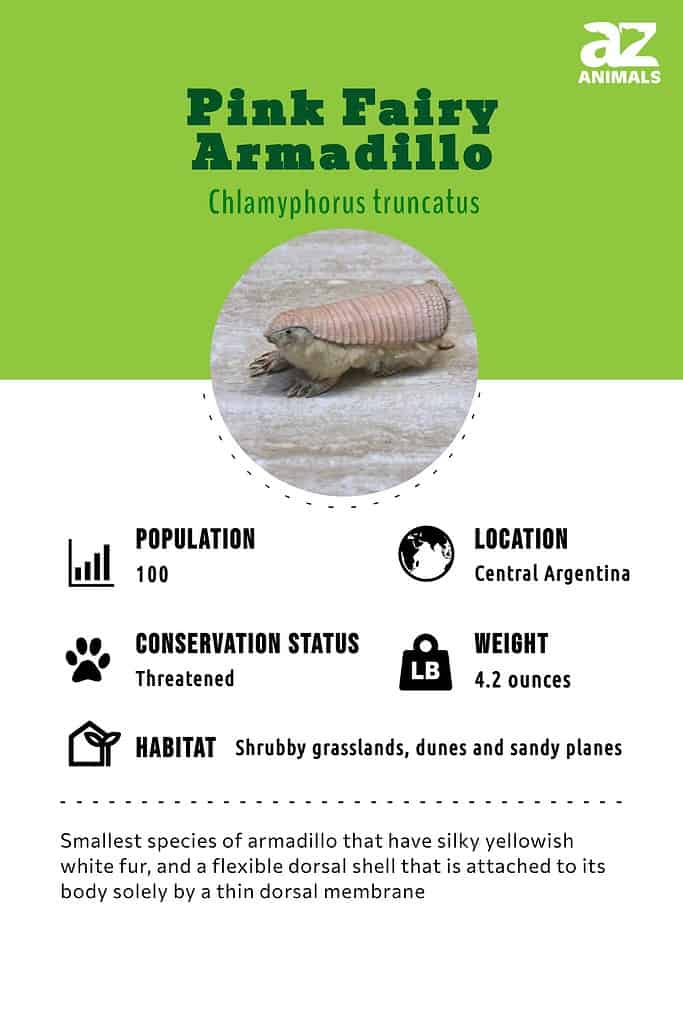
Appearance And Behavior
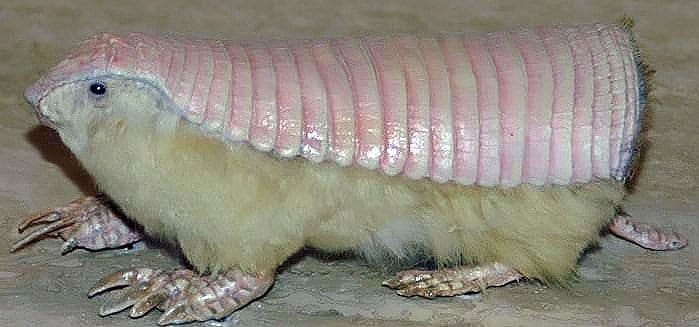
Like other armadillos, pink fairy armadillos have a shell (carapace), but it’s softer, thinner, and more flexible and covers about half their body.
©Photo by David J. Stang / Creative Commons – Original / License
At only 120g and approximately 13cm in length, the pink fairy armadillo is the smallest armadillo species. It is also extremely elusive, spending most of its life beneath the ground. It is also nocturnal, only emerging at night to gather food. Similar to other fossorial species, the pink fairy has claws on its front legs used for digging, a fusiform body shape, and minimal eye size. It also has a carapace (protective shell). Their shell of armor is light pink in color and contains 24 total bands. The shell forms a blunt end due to an extra vertical plate at the end of the shell. In total, this mammal has 28 teeth. These are all the same shape and have no enamel.
Unlike other armadillo species, the pink fairy armadillo has no visible ears and an additional large plate on the back of their head. Uniquely, the fairy armadillo’s shell is not primarily used for protection. Instead, the main function is for thermoregulation. The armadillo can flush the blood vessels in its shell (hence the pink color), and adjust its body temperature. If the armadillo exposes more of its blood to the cool air it can lower its temperature. Inversely, draining the shell allows the animal to better retain heat. Their shell is also not entirely attached to its body. A thin membrane runs along the creature’s spinal column for attachment.
Due to their low basal metabolic rates, pink fairy armadillos have a low body temperature and a high thermal conductance. Their metabolic rate is up to 60 percent lower than what is generally expected for a mammal of that body mass. This allows the them to help maintain its body temperature while in its burrow. Smaller creatures generally always have a tougher time retaining body heat due to their higher surface-area-to-volume ratio. This is why larger animals tend to live in colder environments while smaller animals are more often found in desert environments.
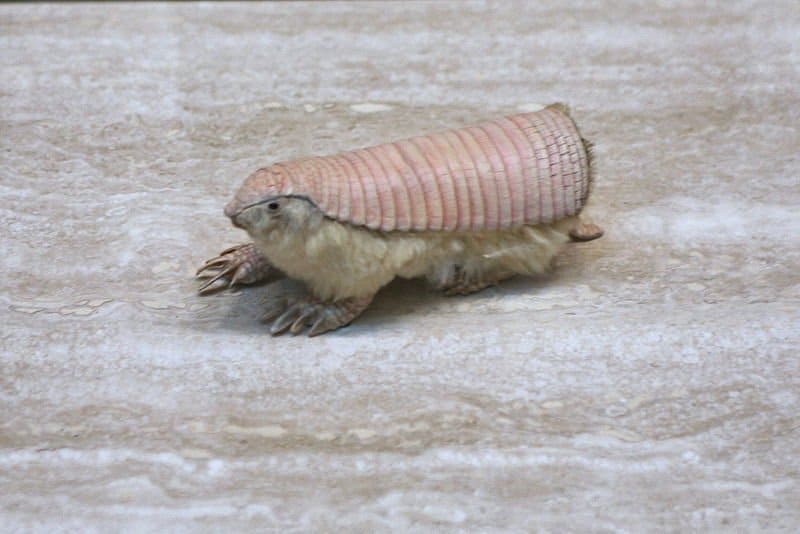
Habitat
Pink fairy armadillos can be found in the deserts and dry scrub lands of central Argentina and other parts of South America. Found primarily in the Neotropical regions of Mendoza, Buenos Aires, San Luis, La Pampa, and San Juan, the pink fairy armadillo’s geographic range is limited to areas in the east because of heavy rainfall in other regions. Because they tunnel only 6 inches below the surface, even modest rainfall can result in flooded burrows. Due to climate change and adverse conditions, it is predicted that the current population is low. The animal has been found from 1,500m in elevation all the way down to sea level.
Diet
The Pink Fairy Armadillo is an omnivore. Their diet mainly consists of ants, but occasionally also snails, plant matter, and worms. The creature often builds complex tunnel systems within close proximity to ant hills, and primarily emerges to gather food during the nighttime.
Predators & Threats
The most common predator for pink fairy armadillos are domestic dogs and cats. Because the armored shell on the animal’s back offers minimal protection, the creature often retreats underground as a primary defense mechanism. Humans can be deadly to the pink fairy armadillo in a number of ways. The animal often falls prey to vehicles while attempting to cross a road. Also, if a pink fairy armadillo is taken in as a pet, it will likely become overwrought with stress and be unable to adapt to the artificial diet provided to them. It is estimated that more than 95 percent of pink fairy armadillos that fall into captivity die within eight days of being captured. Because pink fairy armadillos tunnel so close to the surface, converting their natural habitats to farmland or grazing areas for cattle, their tunnel systems can damage quickly.
According to the research that has been gathered, the population of the pink fairy armadillo continues to decrease, resulting in the animal being listed as a threatened species since 1970.
Reproduction, Babies, And Lifespan
The pink fairy armadillo leads a solitary life except during mating. A female generally gives birth to a single young during a mating cycle. The baby armadillo’s shell is soft at birth and will only become entirely hardened once it has grown into an adult.
The males have no external testicles and the females have two nipples. When mating, males will monitor the female and approach her. The male will then touch the female’s dorsal area, which results in the female wagging her tail. The male will proceed by sniffing the female and maintaining proximity.
There have been no long-term studies conducted on the pink fairy armadillo lifespan. In captivity, the longest life span noted has been four years. Most of these animals die only a few days after being taken in. Younger pink fairy armadillos have the lowest chance of survival in captivity, while adult females have the best chance of survival.
View all 192 animals that start with PPink Fairy Armadillo FAQs (Frequently Asked Questions)
Are pink fairy armadillos herbivores, omnivores, or carnivores?
The pink fairy armadillo is an omnivore. Ants act as this animal’s primary source of food, though they are also known to forage on plant matter, worms, and snails. The pink fairy armadillo uses its digging abilities to burrow into ant colonies and sometimes forages for small insects above land at night.
Can You have a pink fairy armadillo as a pet?
The pink fairy armadillo cannot survive without its natural habitat, so it is a bad idea to keep a pink fairy armadillo pet. These animals live a nocturnal, subterranean lifestyle, making it impossible for them to live above ground for any extended period of time. Pink fairy armadillos are sometimes illegally removed from the wild to be kept or sold on black markets as pets, but they literally cannot survive captivity. Most die within eight days of being taken away from their habitat.
Why is the pink fairy armadillo pink?
The pink fairy armadillo is pink because of it’s unique thermoregulation abilities. The animal will pump blood into it’s shell to disperse heat, giving it a pinkish hue. This is a critical survival feature because of the hot and arid climate the pink fairy armadillo lives in.
Are Pink Fairy Armadillos Dangerous
While pink fairy armadillos are not dangerous to humans, humans are extremely dangerous to them. Being excessively sensitive to changes in their environment, these animals will only survive a few days out of their natural habitat. When a pink fairy armadillo’s burrow is flooded, this forces them above ground. The creature can then die fairly easily after obtaining hypothermia from its wet fur. If a human gets ahold of the animal, this can also lead to death because of the pink fairy armadillo’s inability to cope with stress.
What Kingdom do Pink Fairy Armadillos belong to?
Pink Fairy Armadillos belong to the Kingdom Animalia.
What phylum do Pink Fairy Armadillos belong to?
Pink Fairy Armadillos belong to the phylum Chordata.
What class do Pink Fairy Armadillos belong to?
Pink Fairy Armadillos belong to the class Mammalia.
What family do Pink Fairy Armadillos belong to?
Pink Fairy Armadillos belong to the family Dasypodidae.
What order do Pink Fairy Armadillos belong to?
Pink Fairy Armadillos belong to the order Cingulata.
What genus do Pink Fairy Armadillos belong to?
Pink Fairy Armadillos belong to the genus Chlamyphorus.
What type of covering do Pink Fairy Armadillos have?
Pink Fairy Armadillos are covered in Hard Shells.
In what type of habitat do Pink Fairy Armadillos live?
Pink Fairy Armadillos live in dry grasslands and sandy plains.
What is the main prey for Pink Fairy Armadillos?
Pink Fairy Armadillos prey on ants, worms, and plant material.
What are some predators of Pink Fairy Armadillos?
Predators of Pink Fairy Armadillos include domestic dogs.
What is the average litter size for a Pink Fairy Armadillo?
The average litter size for a Pink Fairy Armadillo is 1.
What is an interesting fact about Pink Fairy Armadillos?
Pink Fairy Armadillos are the smallest known species of Armadillo.
What is the scientific name for the Pink Fairy Armadillo?
The scientific name for the Pink Fairy Armadillo is Chlamyphorus truncatus.
What is the lifespan of a Pink Fairy Armadillo?
Pink Fairy Armadillos can live for 5 to 10 years.
Thank you for reading! Have some feedback for us? Contact the AZ Animals editorial team.
Sources
- David Burnie, Dorling Kindersley (2011) Animal, The Definitive Visual Guide To The World's Wildlife / Accessed March 19, 2010
- Tom Jackson, Lorenz Books (2007) The World Encyclopedia Of Animals / Accessed March 19, 2010
- David Burnie, Kingfisher (2011) The Kingfisher Animal Encyclopedia / Accessed March 19, 2010
- Richard Mackay, University of California Press (2009) The Atlas Of Endangered Species / Accessed March 19, 2010
- David Burnie, Dorling Kindersley (2008) Illustrated Encyclopedia Of Animals / Accessed March 19, 2010
- Dorling Kindersley (2006) Dorling Kindersley Encyclopedia Of Animals / Accessed March 19, 2010
- David W. Macdonald, Oxford University Press (2010) The Encyclopedia Of Mammals / Accessed March 19, 2010

